You’re paying for electricity you’re not even using. Those devices plugged into your walls—televisions, gaming consoles, coffee makers—they’re quietly draining power 24/7, even when they appear to be “off.” This phantom energy consumption can add hundreds of dollars to your annual electricity bill. Smart power strips offer a surprisingly simple solution to this costly problem, but there’s more to choosing the right one than you might expect.
What Are Smart Power Strips and How Do They Work
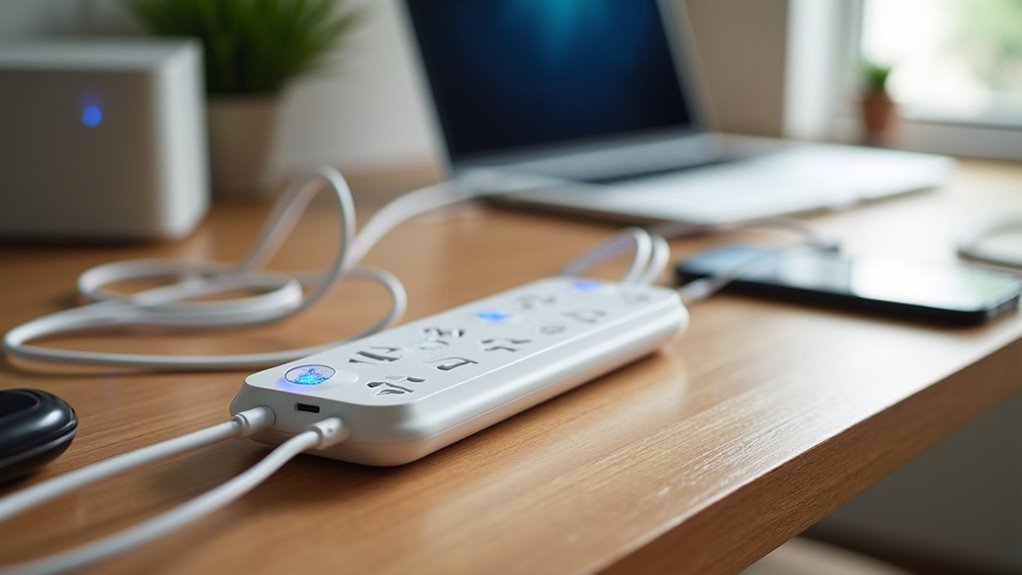
Smart power strips act as intelligent energy guardians for your home, automatically monitoring and controlling the electricity flowing to your connected devices.
These advanced power strips detect when your electronics enter standby mode and cut off electricity to prevent phantom power drain, which typically accounts for 5-10% of household energy consumption.
You’ll find multiple outlet types on smart power strips: always-on outlets for devices needing constant power like routers, and switched outlets that turn off when your control device shuts down.
When you power down your TV or computer, the strip automatically cuts electricity to connected peripherals like speakers, printers, and gaming consoles.
This intelligent switching eliminates wasteful standby power, reducing your energy consumption while protecting your devices from power surges.
The Hidden Cost of Energy Vampires in Your Home
You’re likely unaware that many of your electronics continue drawing power even when they’re turned off, creating what experts call “energy vampires” that silently drain your wallet.
These phantom loads cost your household roughly $200 annually and contribute to over $19 billion in wasted energy across U.S. homes each year.
Identifying which devices are secretly consuming power in standby mode is the first step toward reclaiming control of your energy bills.
What Are Energy Vampires
Lurking throughout your home are silent energy thieves that continue draining power even when you’ve turned off your devices. These energy vampires are electronics that maintain power consumption while in standby mode, quietly inflating your electricity bill. You’ll find them disguised as everyday conveniences—televisions with glowing indicators, computer monitors awaiting your return, and phone chargers plugged into walls.
| Device Type | Standby Power Draw | Annual Cost Impact |
|---|---|---|
| Television | 5-15 watts | $15-45 |
| Computer/Monitor | 10-25 watts | $30-75 |
| Cable Box | 15-30 watts | $45-90 |
| Gaming Console | 8-20 watts | $25-60 |
| Phone Chargers | 2-5 watts | $6-15 |
These phantom loads collectively consume 5-10% of your household’s total energy, costing you roughly $200 annually while contributing to environmental degradation.
Annual Waste Costs
The financial impact of these energy vampires extends far beyond your individual household expenses. Nationwide, standby devices waste over 100 billion kilowatt-hours annually, translating to more than $19 billion in annual waste costs across the U.S.
You’re likely contributing about $200 yearly to this staggering figure through phantom power drain in your own home.
These annual waste costs represent approximately 5-10% of your total household energy consumption, making energy conservation efforts particularly valuable.
When you multiply your $200 annual loss by millions of households, the collective financial burden becomes clear.
Smart power strips offer a practical solution to combat these hidden expenses, potentially reducing your contribution to this massive energy waste while putting money back in your pocket through improved energy conservation practices.
Phantom Power Detection
How can you identify which devices are secretly draining power when they appear to be off? Your electronics continue consuming energy even in standby mode, creating phantom power that silently increases your bills.
Smart power strips solve this problem by actively monitoring your devices’ energy consumption patterns. These intelligent strips automatically detect when devices enter standby mode and cut power accordingly.
They distinguish between active use and phantom power consumption, ensuring your devices receive electricity only when needed.
Key detection methods include:
- Current sensing technology that monitors electrical flow to identify standby consumption
- Remote control signals that detect when devices switch to inactive states
- Timer-based controls that eliminate power after predetermined periods of inactivity
Smart power strips eliminate guesswork by handling phantom power detection automatically.
Types of Smart Power Strips Available Today
Five distinct categories of smart power strips dominate today’s market, each engineered to address specific energy management needs and usage scenarios.
Timer-based smart power strips let you schedule when devices turn on and off, making energy saving effortless during predictable downtime periods.
Master-Controlled strips automatically power peripheral devices when you activate a primary device like your TV or computer, eliminating unnecessary standby consumption.
Masterless models take things further by completely cutting power to devices in standby mode, preventing phantom drain entirely.
Activity Monitor strips provide real-time energy consumption data, helping you identify which devices consume the most power.
Remote Switch variants offer smartphone control, letting you manage your devices from anywhere for maximum convenience and efficiency.
Master-Controlled Vs Masterless Power Strip Systems
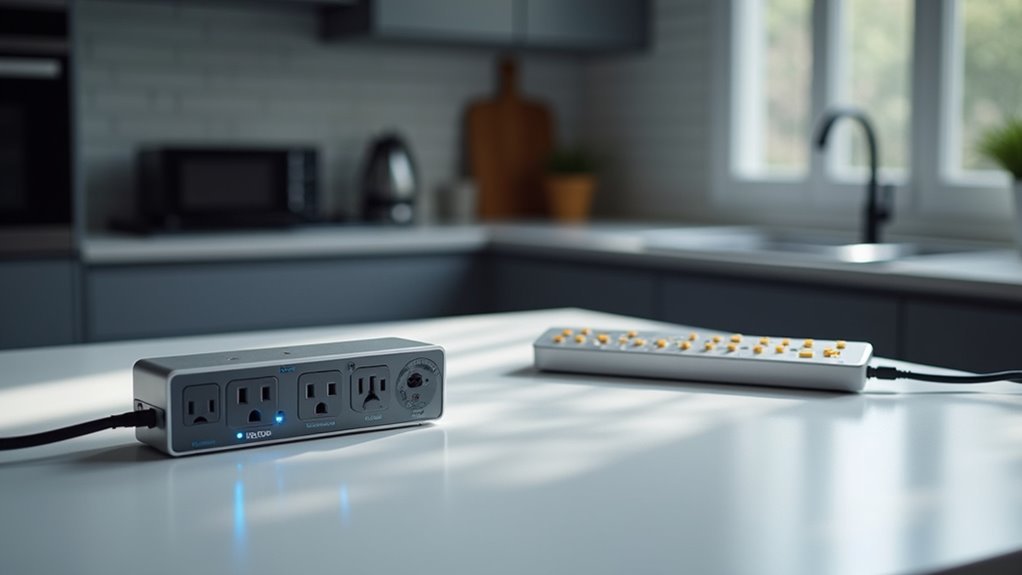
When you’re deciding between master-controlled and masterless smart power strips, understanding their fundamental differences will dictate which system best fits your energy-saving goals.
A master-controlled power strip uses your primary device—like your TV or computer—to automatically control peripheral power supply. When you turn off the main device, connected peripherals shut down too, creating seamless automation for your entertainment center or workspace.
Masterless power strips take a different approach by completely cutting power to devices in standby mode, eliminating phantom power drain entirely. This guarantees zero energy waste when devices aren’t actively used.
Key considerations for choosing your system:
- Device compatibility: Assess your equipment’s power requirements and standby needs
- Usage patterns: Consider how frequently you use connected devices together
- Energy goals: Determine whether automation or complete power elimination suits your efficiency targets
Essential Safety Guidelines for Smart Power Strip Installation
Before installing your smart power strip, you’ll need to understand its wattage capacity limits to prevent dangerous overloads.
Don’t plug high-wattage appliances like hair dryers or microwaves into these strips, as they can cause electrical fires or damage.
You should also consider proper device placement by avoiding daisy-chaining multiple power strips together, which creates unsafe electrical conditions.
Wattage Capacity Limits
Understanding your smart power strip’s wattage capacity limits prevents dangerous electrical overloads that could damage your devices or start fires. Every circuit has a maximum capacity that shouldn’t be exceeded when connecting devices to your smart power strips.
Before plugging in equipment, calculate the total wattage of all connected devices and verify it doesn’t surpass your strip’s specified rating. Regular monitoring helps maintain safe operation.
- Never connect high-wattage appliances like hair dryers, microwaves, or space heaters to power strips.
- Avoid daisy-chaining multiple strips or extension cords, which increases overload risk.
- Check device wattage requirements regularly, especially for high-draw equipment like amplifiers.
You’ll protect your home and devices by respecting wattage capacity limits and following proper usage guidelines.
Proper Device Placement
Beyond managing wattage limits, the physical placement of your smart power strips and connected devices directly impacts electrical safety and performance.
You’ll want to position your power strip in a well-ventilated area, away from heat sources like radiators or direct sunlight that could cause overheating.
When determining proper device placement, plug high-wattage appliances such as hair dryers and microwaves directly into wall outlets rather than using your smart power strip. This prevents electrical overload and reduces fire hazards.
Never daisy-chain multiple power strips or extension cords together, as this creates dangerous overheating conditions.
Regularly inspect your power strip for wear, damage, or signs of overheating, replacing any malfunctioning units immediately to maintain safe operation throughout your home.
How to Calculate Wattage Requirements for Your Setup
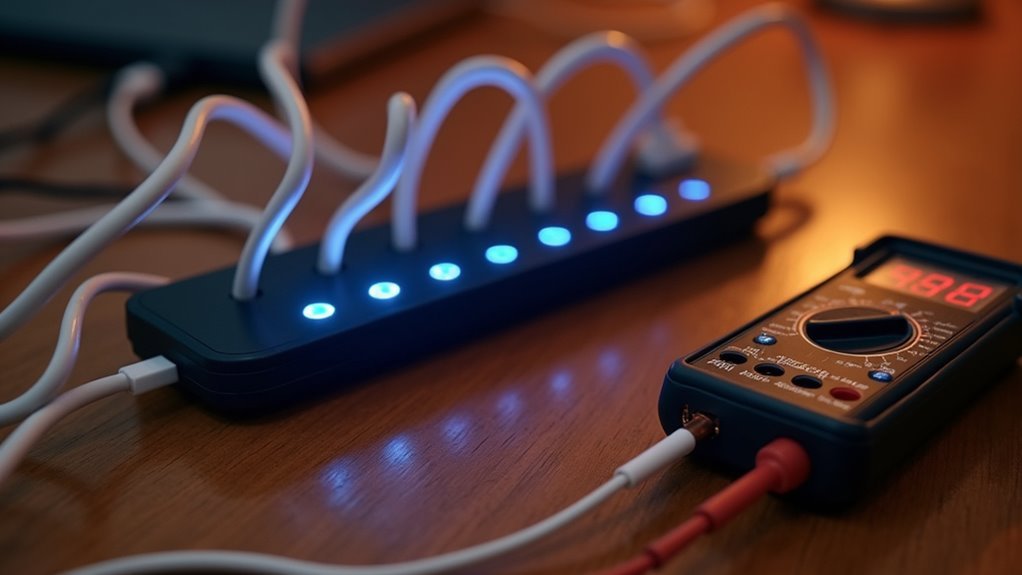
One essential step in setting up your smart power strip safely involves calculating the total wattage requirements of all connected devices.
You’ll need to identify each device’s wattage, typically found on labels or user manuals, then add them together for your total consumption.
- Check individual device wattage – Look for power ratings on device labels or specifications to determine exact consumption
- Maintain a safety buffer – Keep your total usage 20-25% below the power strip’s maximum capacity to handle power fluctuations
- Avoid high-wattage devices – Don’t connect hair dryers, microwaves, or similar appliances that can overload smart power strips
Consider startup power spikes when calculating wattage requirements, as some devices temporarily need more electricity during initial operation than their continuous rating indicates.
Step-by-Step Guide to Setting Up Your Smart Power Strip
Once you’ve calculated your wattage requirements, you’re ready to begin the physical setup process for your smart power strip.
Start by plugging your TV or PC into the Control outlet, which manages power to connected devices based on your control device’s status.
Connect devices requiring constant power, like cable boxes or modems, to Always On outlets to maintain functionality.
Use Switched outlets for peripherals such as soundbars or Blu-ray players—they’ll automatically turn on and off with your control device, reducing energy waste like a smart plug.
Adjust the user ON-OFF THRESHOLD for best sensitivity, ensuring devices power down when not in use.
After setup, regularly monitor energy usage to track savings and enhance efficiency.
Best Devices to Connect to Your Smart Power Strip
With your smart power strip properly configured, selecting the right devices to connect becomes the key to maximizing energy savings.
You’ll want to focus on electronics that consume standby power when not actively in use.
Perfect candidates for smart power strips include:
- Entertainment systems – TVs, gaming consoles, receivers, and subwoofers that consume phantom power in standby mode
- Computer workstations – Monitors, printers, and speakers that can automatically power down when your main computer shuts off
- Audio equipment – Receivers and subwoofers benefit from automatic shutoff, extending their lifespan while reducing energy costs
Connect routers and cable boxes to always-on outlets to maintain internet connectivity.
Avoid high-wattage appliances like hair dryers or microwaves, as they can overload the strip and create safety hazards.
Appliances You Should Never Plug Into Power Strips
While smart power strips offer excellent energy-saving benefits, certain appliances pose serious safety risks when connected to them. Understanding which appliances you should never plug into power strips can prevent dangerous electrical hazards and potential fires.
| High-Risk Appliances | Why They’re Dangerous |
|---|---|
| Hair dryers & microwaves | Easily overload circuits |
| Space heaters & toasters | Exceed power strip capacity |
| Refrigerators & freezers | Require direct wall connection |
These devices consume significant power that can cause overheating when multiple high-draw appliances share a single strip. Electrical safety guidelines specifically recommend using wall outlets for any appliance producing heat or containing motors. Don’t risk your home’s safety by overloading power strips with heavy-duty equipment.
Top Smart Power Strip Models and Their Features
You’ll find today’s smart power strips offer impressive features that go far beyond basic surge protection.
Leading models now include remote control capabilities, USB charging ports, and advanced scheduling functions that let you automate your devices.
When comparing these technologies, you’ll notice significant differences in compatibility, energy monitoring, and specialized features like motion sensors or color-coded outlets.
Leading Model Features
Several standout smart power strips offer distinct features that cater to different user needs and preferences.
You’ll find models that integrate seamlessly with smart thermostats and help you save energy through innovative technologies.
The Kasa Smart Plug Power Strip delivers extensive control with three outlets, two USB ports, and app-based scheduling.
Meanwhile, the Eve Energy Strip provides Apple HomeKit compatibility with well-spaced outlets for larger adapters.
The Isolé IDP-3050 stands out with its motion sensor technology, automatically managing power based on room occupancy.
Key features to take into account include:
- Color-coded outlets for easier device identification and control
- Surge protection to safeguard your valuable electronics
- Remote monitoring capabilities for real-time energy management
Choose based on your specific automation needs and device compatibility requirements.
Advanced Technology Comparison
Each smart power strip model incorporates distinct technologies that set them apart in today’s competitive market.
You’ll find the Kasa Smart Plug Power Strip offers three smart outlets with extensive app-based remote control and scheduling capabilities.
The Eve Energy Strip provides seamless Apple HomeKit integration, though it’s not compatible with OhmConnect systems.
For visual energy management, the Smart Strip LGC3 features color-coded outlets that help you monitor energy usage efficiently.
The Isolé IDP-3050 takes automation further with motion sensor technology that automatically manages power based on room occupancy.
Meanwhile, the Belkin Conserve focuses on convenient remote power management, letting you control devices without physical access to outlets.
Each model addresses different energy management priorities through specialized technological approaches.
Measuring Your Energy Savings With Smart Power Strips
When you install smart power strips in your home, tracking the actual energy savings becomes straightforward through built-in monitoring capabilities that display real-time consumption data.
These devices automatically measure energy usage across connected appliances, giving you precise insights into where your electricity dollars go each month.
You’ll discover significant savings opportunities when you identify which devices drain phantom power during standby mode. Smart power strips eliminate this waste by cutting power completely to inactive electronics, typically saving households around $200 annually.
Key measurement features include:
- Real-time energy consumption tracking for individual devices and device groups
- Historical usage data analysis to identify peak consumption patterns
- Cost calculations showing exact dollar amounts saved through automated power management
This data empowers you to optimize your energy habits and maximize long-term savings.
Troubleshooting Common Smart Power Strip Issues
You might encounter several frustrating issues when using smart power strips that can disrupt their effectiveness.
Common problems include devices that won’t respond properly due to compatibility conflicts, sensitivity settings that don’t detect standby modes correctly, and poorly designed outlets that make it difficult to plug in multiple devices.
Understanding these three main troubleshooting areas will help you resolve most smart power strip malfunctions quickly.
Device Compatibility Problems
Although smart power strips offer impressive energy-saving capabilities, they can encounter compatibility issues that prevent your devices from functioning properly.
Device compatibility problems with smart power strips often stem from mismatched power requirements or incorrect outlet usage.
To minimize these issues, consider these essential guidelines:
- Power allocation: Make sure your connected devices don’t exceed the strip’s maximum wattage capacity to prevent overload and potential failure.
- Outlet selection: Connect constant-power devices like routers to Always On outlets, while placing peripherals like printers in switched outlets.
- High-wattage restrictions: Avoid connecting hair dryers or microwaves, as these create serious safety hazards.
Additionally, you’ll need to adjust sensitivity settings if your smart power strips struggle with standby mode detection, and understand your USB port configurations for peak performance.
Sensitivity Adjustment Issues
Even after resolving compatibility concerns, smart power strips can frustrate users with sensitivity adjustment problems that undermine their energy-saving potential.
You’ll find that incorrect sensitivity settings cause devices to shut off unexpectedly or fail to cut power when they should enter standby mode. This inconsistent performance leads to unexpected energy consumption, defeating the purpose of using smart power strips.
Finding the ideal sensitivity setting requires patience and experimentation. You must manually calibrate the sensors to match your devices’ varying power draws. Different manufacturers offer varying levels of precision, so effectiveness depends on your specific model’s capabilities.
Reading your user manual thoroughly helps prevent these issues. Following proper setup instructions guarantees your smart power strip functions correctly for effective energy management.
Outlet Design Limitations
Beyond sensitivity problems, physical design flaws in smart power strips create frustrating limitations that prevent you from maximizing their utility.
The most common issue you’ll encounter is outlets positioned too closely together, which restricts how many devices you can actually connect simultaneously. This design flaw becomes particularly problematic when you’re trying to plug in multiple adapters or larger plugs.
These spacing constraints force you to make difficult choices about which devices to connect, ultimately reducing the strip’s effectiveness.
Consider these key outlet design challenges:
- Cramped outlet spacing prevents full utilization of available ports
- Large power adapters block adjacent outlets completely
- Insufficient clearance between outlets limits device compatibility
Understanding these limitations helps you monitor power usage more effectively and select strips with better outlet arrangements.
Integrating Smart Power Strips With Other Home Automation
While smart power strips offer impressive standalone functionality, their true potential emerges when you integrate them with your broader home automation ecosystem. You can control multiple devices through a single app or voice command by connecting smart power strips to platforms like Apple HomeKit or Google Assistant. This seamless integration enhances both convenience and energy efficiency.
You’ll benefit from scheduling capabilities that automate device usage during non-peak hours, reducing energy waste. The system monitors your consumption and sends alerts when devices are unnecessarily left on.
When paired with smart thermostats, your smart power strips contribute to extensive energy management, potentially saving hundreds of dollars annually by eliminating phantom power consumption throughout your home.
Cost-Benefit Analysis of Upgrading to Smart Power Strips
Understanding the financial implications of smart power strip adoption requires examining both upfront costs and long-term savings potential.
You’ll find that smart power strips cost roughly the same as traditional models, yet they deliver substantial returns through reduced energy waste. Traditional electronics in standby mode consume 5-10% of your household energy, contributing to over $19 billion in annual U.S. waste.
The benefits extend beyond immediate savings:
- Extended device lifespan through automated power management that prevents constant power draw
- Surge protection that safeguards your electronics from costly electrical damage
- Environmental impact reduction of approximately 80 million tons of carbon emissions annually
You’re fundamentally getting multiple protective features while cutting electricity bills, making smart power strips a financially sound investment that pays dividends through reduced consumption and device protection.
Frequently Asked Questions
Do Smart Power Strips Really Work?
Yes, you’ll see real results with smart power strips. They’ll automatically cut standby power from your electronics, reducing your energy bills by 5-10% while eliminating phantom loads that waste electricity unnecessarily.
Do Power Strips Raise Electric Bill?
Power strips don’t directly raise your electric bill, but they’ll increase costs if you leave devices plugged in. Electronics in standby mode create phantom power drain, potentially adding $200 annually to your household expenses.
How Much Energy Do Smart Power Strips Save?
You’ll save up to 10% on household energy consumption by eliminating phantom power drain. Smart power strips can cut your electricity bills by approximately $200 annually while reducing carbon emissions greatly.
What Should You Never Plug Into a Surge Protector?
You shouldn’t plug high-wattage appliances like hair dryers, microwaves, refrigerators, or medical equipment into surge protectors. They’ll exceed power ratings, risk overheating, and potentially cause fires or equipment failure.

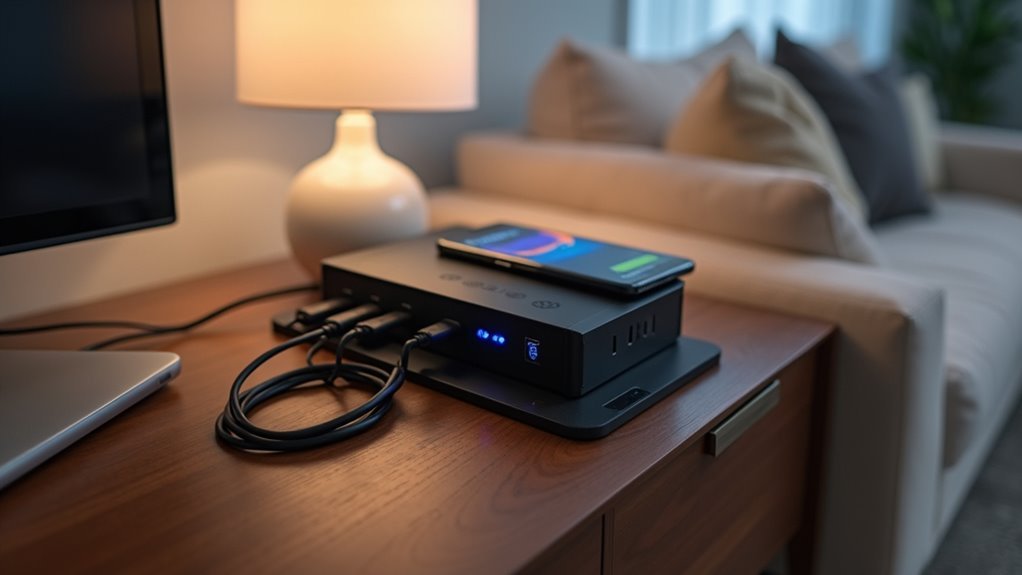
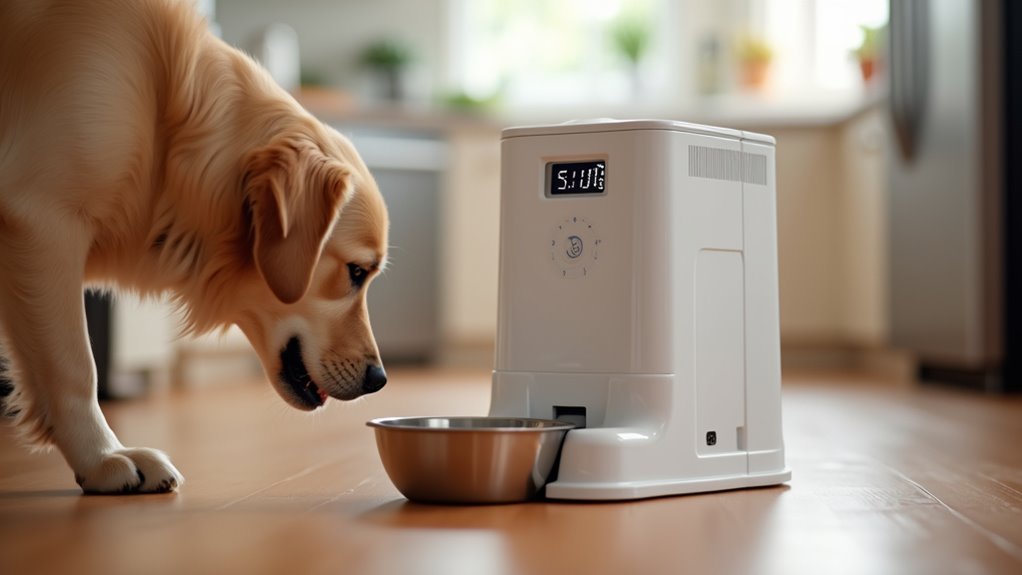
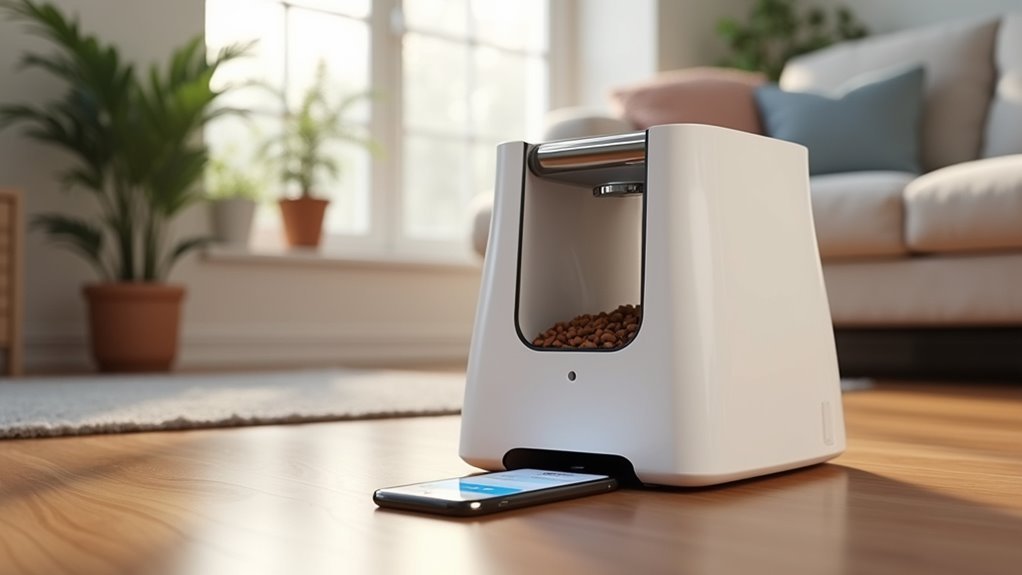

Leave a Reply